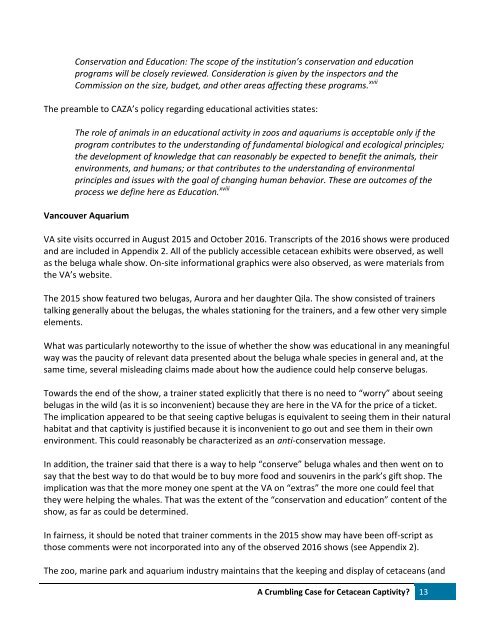A CRUMBLING CASE FOR CETACEAN CAPTIVITY?
MM-Education-and-Conservation-Report-Dec-9-2016-fi
MM-Education-and-Conservation-Report-Dec-9-2016-fi
You also want an ePaper? Increase the reach of your titles
YUMPU automatically turns print PDFs into web optimized ePapers that Google loves.
Conservation and Education: The scope of the institution’s conservation and education<br />
programs will be closely reviewed. Consideration is given by the inspectors and the<br />
Commission on the size, budget, and other areas affecting these programs. xvii<br />
The preamble to CAZA’s policy regarding educational activities states:<br />
The role of animals in an educational activity in zoos and aquariums is acceptable only if the<br />
program contributes to the understanding of fundamental biological and ecological principles;<br />
the development of knowledge that can reasonably be expected to benefit the animals, their<br />
environments, and humans; or that contributes to the understanding of environmental<br />
principles and issues with the goal of changing human behavior. These are outcomes of the<br />
process we define here as Education. xviii<br />
Vancouver Aquarium<br />
VA site visits occurred in August 2015 and October 2016. Transcripts of the 2016 shows were produced<br />
and are included in Appendix 2. All of the publicly accessible cetacean exhibits were observed, as well<br />
as the beluga whale show. On-site informational graphics were also observed, as were materials from<br />
the VA’s website.<br />
The 2015 show featured two belugas, Aurora and her daughter Qila. The show consisted of trainers<br />
talking generally about the belugas, the whales stationing for the trainers, and a few other very simple<br />
elements.<br />
What was particularly noteworthy to the issue of whether the show was educational in any meaningful<br />
way was the paucity of relevant data presented about the beluga whale species in general and, at the<br />
same time, several misleading claims made about how the audience could help conserve belugas.<br />
Towards the end of the show, a trainer stated explicitly that there is no need to “worry” about seeing<br />
belugas in the wild (as it is so inconvenient) because they are here in the VA for the price of a ticket.<br />
The implication appeared to be that seeing captive belugas is equivalent to seeing them in their natural<br />
habitat and that captivity is justified because it is inconvenient to go out and see them in their own<br />
environment. This could reasonably be characterized as an anti-conservation message.<br />
In addition, the trainer said that there is a way to help “conserve” beluga whales and then went on to<br />
say that the best way to do that would be to buy more food and souvenirs in the park’s gift shop. The<br />
implication was that the more money one spent at the VA on “extras” the more one could feel that<br />
they were helping the whales. That was the extent of the “conservation and education” content of the<br />
show, as far as could be determined.<br />
In fairness, it should be noted that trainer comments in the 2015 show may have been off-script as<br />
those comments were not incorporated into any of the observed 2016 shows (see Appendix 2).<br />
The zoo, marine park and aquarium industry maintains that the keeping and display of cetaceans (and<br />
A Crumbling Case for Cetacean Captivity? 13


